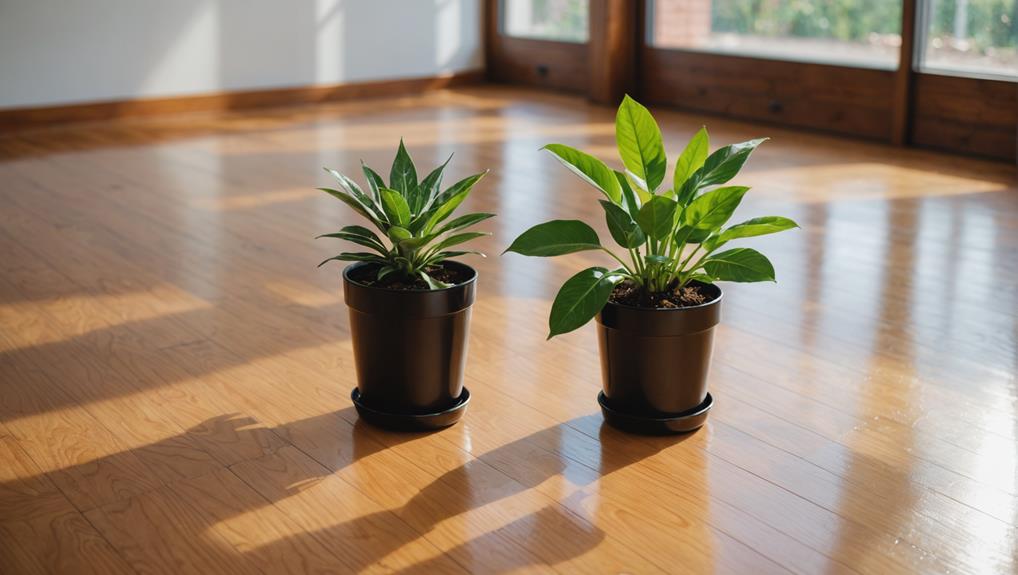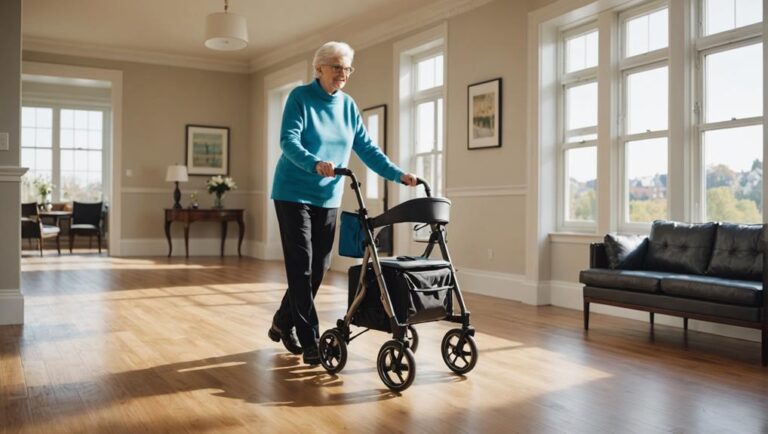To prevent yellowing in floor sealants, choose water-based polyurethane sealants as they're less prone to discoloration. Store sealants in controlled temperatures away from direct sunlight. Prepare surfaces thoroughly and apply sealants evenly, following manufacturer guidelines. Maintain humidity levels between 30% and 50%, and keep application temperatures between 60°F and 85°F. Limit UV exposure by using window treatments or applying sealants in shaded areas. Regularly clean surfaces using pH-neutral cleaners and conduct monthly visual inspections for wear. By staying proactive about maintenance, you can enhance the longevity and appearance of your floor sealants. There's more to uncover on this topic.
Understanding Yellowing Causes
Understanding the causes of yellowing in floor sealants is important to maintaining their appearance and longevity. Several factors contribute to this issue, primarily involving chemical reactions and material degradation. One significant cause is the aging effects of the sealant itself, which can lead to a breakdown of the product formulation over time, causing discoloration.
Environmental factors also play an essential role. For instance, UV stability is critical; prolonged exposure to ultraviolet light can initiate chemical reactions that accelerate yellowing. Similarly, heat exposure, especially in poorly ventilated areas, can exacerbate these reactions, leading to noticeable changes in color.
Improper storage is another important consideration. If sealants are stored in extreme temperatures or direct sunlight, it can adversely affect their performance and aesthetic. Application errors, such as uneven layering or incorrect curing techniques, can also trap surface contaminants, which may contribute to discoloration.
Moreover, surface contaminants like dirt or oils can interact with the sealant, further promoting degradation and yellowing. Regular maintenance and cleaning can help mitigate these risks. By understanding these causes, you can take proactive measures to protect your floor sealants. This awareness not only enhances their visual appeal but also extends their lifespan, ensuring that your floors remain safe and attractive for years to come.
Choosing the Right Sealant
Selecting the right sealant is key to preventing yellowing and preserving the beauty of your floors. When choosing a sealant, you need to take into account various sealant types available on the market. Water-based polyurethane sealants are often recommended for their low odor and reduced risk of yellowing over time. They provide a clear finish that enhances the natural color of your sol while offering robust protection against wear and tear.
In contrast, oil-based sealants tend to provide a richer, warmer tone but are more prone to yellowing due to their chemical composition. If you prioritize a long-lasting finish with minimal yellowing, water-based options should be your go-to choice. Additionally, some sealants are specifically formulated to resist UV damage, which can also contribute to yellowing.
When it comes to application finishes, you'll want to choose a product that complements your flooring type. For instance, a satin or matte finish can help mask minor imperfections, while a glossy finish might highlight them. Each finish type can affect the overall appearance and longevity of your floor, so it's crucial to match it with your desired aesthetic and functional needs.
Before making a final decision, always review safety data sheets to verify the sealant meets your health and safety standards. This precaution not only protects your investment but also promotes a safe living environment.
Proper Application Techniques
To prevent yellowing in floor sealants, proper application techniques are essential. You need to make certain the surface is thoroughly prepared, as any contaminants can affect adhesion and discoloration. Additionally, applying the sealant evenly will help maintain its clarity and longevity.
Surface Preparation Importance
Proper surface preparation is essential for guaranteeing the longevity and appearance of floor sealants. Neglecting this step can lead to poor adhesion and eventual yellowing, compromising the integrity of your flooring. Begin with surface cleaning to remove dust, dirt, and debris. This increases the sealant's bonding capability, allowing it to perform effectively. Following that, conduct a substrate assessment to identify any underlying issues like moisture or structural damage. Addressing these problems before applying the sealant is vital for long-term success.
Here's a quick reference table to help you with surface preparation:
| Step | Importance |
|---|---|
| Surface Cleaning | Removes contaminants for better adhesion. |
| Substrate Assessment | Identifies issues that could affect sealant performance. |
| Repairing Damage | Guarantees a stable foundation for the sealant application. |
Even Application Technique
Achieving an even application of floor sealants is essential for their performance and appearance. To guarantee ideal results, you'll want to employ proper application techniques, which greatly reduce the risk of yellowing. Whether you're using spray techniques or roller application, consistency is key.
When using spray techniques, maintain a steady distance from the surface, typically between 8 to 12 inches. This helps prevent uneven distribution and pooling, which can lead to discoloration. Use smooth, overlapping passes to create a uniform layer. If you're opting for roller application, choose a high-quality roller with a nap suited for your sealant type. Apply the sealant in manageable sections, working in a 'W' pattern to guarantee even coverage.
Regardless of the method, always follow the manufacturer's guidelines regarding application thickness and drying times. Applying too thickly can trap moisture and contribute to yellowing. Additionally, be mindful of environmental conditions; high humidity or extreme temperatures can adversely affect the application process. By mastering these techniques, you'll enhance the longevity and clarity of your floor sealants while minimizing the risk of yellowing.
Maintaining Optimal Conditions
To prevent yellowing in floor sealants, you need to maintain ideal conditions in your environment. Control humidity levels, regulate temperature variations, and limit UV exposure to guarantee the longevity and clarity of your sealants. By managing these factors, you can greatly reduce the risk of discoloration over time.
Control Humidity Levels
Maintaining ideal humidity levels is crucial for preventing yellowing in floor sealants. High humidity can lead to excessive moisture accumulation, which compromises the integrity of the sealant and accelerates yellowing. To effectively manage this, you should implement humidity control measures in your environment. Aim for a relative humidity level between 30% and 50%, as levels outside this range can negatively impact sealant performance.
Utilizing dehumidifiers or air conditioning can assist in moisture management, especially in areas prone to high humidity. Regularly monitor humidity levels using a hygrometer, verifying it remains within the recommended range. Additionally, proper ventilation in spaces such as basements and kitchens can considerably reduce moisture buildup.
If installing new flooring or applying sealants, consider timing your projects during drier seasons to minimize humidity-related issues. Moreover, make sure that any spills or moisture on the floor are promptly cleaned up to prevent prolonged exposure to humidity.
Regulate Temperature Variations
During the application and curing process of floor sealants, regulating temperature variations is essential for preventing yellowing. Maintaining temperature control guarantees that the sealant adheres properly and cures effectively, which directly impacts its durability and appearance. Here are some key points to keep in mind for ideal conditions:
- Maintain a stable temperature – Aim for a consistent environment between 60°F and 85°F during application.
- Use thermal insulation – Insulate your workspace to minimize fluctuations caused by external weather conditions.
- Monitor indoor climate – Utilize thermometers and hygrometers to keep track of temperature and humidity levels.
- Avoid drafts – Seal windows and doors to prevent cold air from interfering with the curing process.
Limit UV Exposure
Regulating temperature variations contributes greatly to the overall success of floor sealants, but another key factor in preventing yellowing is limiting UV exposure. UV rays can markedly degrade the color stability of sealants over time, leading to unsightly discoloration. To combat this, consider using UV blockers in your sealant formulations. These additives can enhance the resistance of the sealant to sun damage.
Opting for tinted sealants can also provide additional protection against UV rays. By absorbing harmful wavelengths, tinted options help maintain the original appearance of your floors. When installing outdoor surfaces, utilize outdoor coverings or shade structures to shield the sealant from direct sunlight, further reducing the risk of yellowing.
In spaces with large windows, consider applying window films that filter UV light, which can prolong the life of your sealant. Additionally, using reflective surfaces around the floor area can help bounce UV rays away, minimizing their impact.
Pratiques de nettoyage régulières
To keep your floor sealants looking their best, implementing regular cleaning practices is essential. By maintaining a consistent cleaning frequency and using suitable products, you can markedly minimize the risk of yellowing and enhance the longevity of your sealants. Here are four key practices to follow:
- Dust and Sweep Regularly: Accumulated dust and debris can scratch the surface, so make it a habit to sweep or dust at least once a week.
- Mop with Care: Use a damp mop with a pH-neutral cleaner specifically designed for sealed floors. Avoid harsh chemicals that can degrade the sealant. Aim to mop every two weeks to maintain cleanliness without over-saturating the area.
- Nettoyer immédiatement les taches: Address spills and stains as soon as they happen. The longer a substance sits on the surface, the more likely it is to cause damage. Use a soft cloth with a suitable cleaner for spot cleaning.
- Use Floor Mats: Place mats at entry points to catch dirt and moisture before they reach your floors. This simple step can drastically reduce the frequency of cleaning required.
Periodic Inspections and Touch-Ups
Periodic inspections and touch-ups play an essential role in preventing yellowing in floor sealants. By conducting timely assessments of your floor's condition, you can identify any issues before they escalate. This proactive approach not only extends the life of your sealant but also maintains the aesthetic appeal of your floors.
During inspections, look for signs of wear, such as scratches, discoloration, or areas where the sealant has worn away. Addressing these issues promptly through sealant maintenance can greatly reduce the risk of yellowing. Touch-ups with compatible sealants can restore the protective layer, ensuring that your floors remain attractive and safe.
Here's a simple guide to help you with your periodic inspections and touch-ups:
| Inspection Task | Fréquence | Action Required |
|---|---|---|
| Visual Check | Mensuel | Look for signs of wear |
| Clean Surface | Bi-Monthly | Remove dirt and debris |
| Touch-Up Sealant | Annually | Reapply sealant as needed |
Questions fréquemment posées
Can Yellowing Be Reversed Once It Occurs?
Did you know that nearly 30% of homeowners report dealing with yellowing in their flooring? Once yellowing occurs, reversing it can be challenging, as it often results from environmental factors or chemical reactions. While you may not fully restore the original appearance, you can minimize the effects through proper cleaning and maintenance. Focusing on yellowing prevention, like choosing UV-resistant sealants, can help you avoid these issues in the first place.
Are There Specific Brands Known to Resist Yellowing?
When choosing sealant materials, you'll want to look for brands that incorporate UV inhibitors, as they greatly reduce yellowing over time. Products like polyurethane and epoxy-based sealants are frequently recommended for their durability and resistance to discoloration. Brands such as Bona and Zinsser have been noted for their effectiveness in maintaining clarity and safety. Always check product specifications to verify they meet your requirements for longevity and performance in high-UV environments.
How Often Should I Reseal My Floors?
You should consider resealing your floors every 3 to 5 years, depending on the sealant lifespan and the wear your floors experience. High-traffic areas may require more frequent attention, while less-used spaces can go longer. Regular inspections can help you determine when it's time for resealing, ensuring your floors maintain their protective layer. This proactive approach not only enhances aesthetics but also safeguards the integrity of your flooring investment.
Does Sunlight Exposure Affect Sealant Yellowing?
Yes, sunlight exposure does affect sealant yellowing. UV rays can break down the sealant formulation, leading to discoloration over time. To combat this, you should choose sealants with UV protection, which help maintain their clarity and integrity. Regularly checking for any signs of yellowing and addressing them promptly will also enhance the lifespan of your floors. Ensuring adequate protection from direct sunlight can greatly reduce the chances of sealant degradation.
Is Yellowing More Common in Certain Climates?
Yes, yellowing can be more common in certain climates. High humidity effects can exacerbate the breakdown of sealants, while temperature variations—especially extreme heat—can accelerate the deterioration process. In humid environments, moisture can get trapped beneath the sealant, causing it to break down faster and yellow. To maintain your floor's appearance, it's vital to choose sealants designed for your specific climate conditions, ensuring long-lasting protection and safety.




